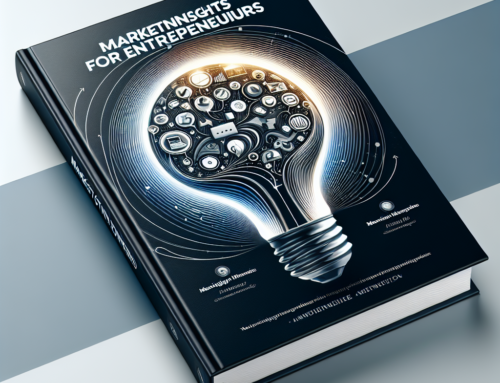
Understanding The Purple Cow: Standing Out In A Crowded Market
In the bustling world of entrepreneurship, standing out in a crowded market can often feel like an insurmountable challenge. However, marketing guru Seth Godin offers a beacon of hope with his concept of the ”Purple Cow.” This idea, which is central to his book of the same name, revolves around the notion that in order to capture attention and thrive, businesses must be remarkable. But what does it mean to be remarkable, and how can entrepreneurs apply this wisdom to their ventures?
To begin with, the term ”Purple Cow” itself is a metaphor for something extraordinary. Imagine driving through the countryside and seeing field after field of cows. After a while, they all blend together, becoming part of the mundane scenery. Now, picture spotting a purple cow among them. Instantly, it grabs your attention because it is unique and unexpected. This is precisely what Godin suggests businesses should strive for: to be so distinctive that they cannot be ignored.
Transitioning from theory to practice, the first step in understanding the Purple Cow is recognizing the importance of innovation. In a market saturated with similar products and services, innovation becomes the key differentiator. Entrepreneurs should focus on creating something that not only meets the needs of their target audience but does so in a way that is novel and exciting. This could mean introducing a groundbreaking product, offering an exceptional customer experience, or even adopting a unique business model.
Moreover, Godin emphasizes the significance of identifying and targeting a niche market. Instead of trying to appeal to everyone, which often results in diluted efforts, entrepreneurs should concentrate on a specific segment of the market that is underserved or overlooked. By catering to the unique needs and preferences of this niche, businesses can build a loyal customer base that values their distinct offerings. This approach not only fosters customer loyalty but also generates word-of-mouth marketing, as satisfied customers are more likely to share their positive experiences with others.
In addition to innovation and niche targeting, Godin also highlights the power of storytelling. In today’s digital age, where consumers are bombarded with information, a compelling story can cut through the noise and create a lasting impression. Entrepreneurs should craft a narrative that resonates with their audience, one that communicates their brand’s values, mission, and the unique benefits of their product or service. A well-told story can humanize a brand, making it more relatable and memorable.
Furthermore, Godin advises entrepreneurs to embrace the concept of ”being remarkable” in every aspect of their business. This means going beyond the product itself and considering how every touchpoint with the customer can be made exceptional. From the design of the website to the packaging of the product, every detail should reflect the brand’s commitment to excellence and uniqueness. By consistently delivering remarkable experiences, businesses can build a strong brand identity that stands out in the minds of consumers.
Lastly, it is crucial for entrepreneurs to be willing to take risks and challenge the status quo. The very essence of the Purple Cow is about daring to be different, even if it means stepping out of one’s comfort zone. While there is always a degree of uncertainty involved, the potential rewards of being remarkable far outweigh the risks. By continuously pushing the boundaries and striving for innovation, entrepreneurs can create a lasting impact in their industry.
In conclusion, Seth Godin’s concept of the Purple Cow offers invaluable lessons for entrepreneurs seeking to stand out in a crowded market. By focusing on innovation, targeting niche markets, crafting compelling stories, delivering remarkable experiences, and embracing risk, businesses can differentiate themselves and capture the attention of their audience. In a world where being ordinary is no longer enough, the Purple Cow serves as a reminder that true success lies in being extraordinary.
The Power Of Permission Marketing: Building Trust With Your Audience
Seth Godin’s marketing wisdom has been a beacon for entrepreneurs navigating the complex world of modern marketing. One of his most influential concepts is permission marketing, a strategy that emphasizes building trust with your audience. Unlike traditional marketing, which often interrupts and intrudes, permission marketing is about earning the right to communicate with potential customers. This approach not only fosters a more respectful relationship but also leads to more engaged and loyal customers.
To understand the power of permission marketing, it’s essential to recognize the shift in consumer behavior. In today’s digital age, people are bombarded with advertisements and marketing messages from every direction. This constant barrage has led to a phenomenon known as ”ad fatigue,” where consumers become desensitized to traditional advertising methods. As a result, they are more likely to ignore or even actively avoid ads. This is where permission marketing comes into play. By seeking permission before delivering marketing messages, businesses can cut through the noise and reach their audience in a more meaningful way.
One of the key lessons from Seth Godin’s philosophy is the importance of offering value in exchange for permission. This value can come in many forms, such as informative content, exclusive offers, or personalized recommendations. The idea is to give your audience a reason to opt-in and stay engaged. For instance, a company might offer a free e-book or a discount code in exchange for signing up for their newsletter. This not only provides immediate value but also sets the stage for a long-term relationship built on trust.
Another crucial aspect of permission marketing is transparency. Being upfront about what your audience can expect from you helps build credibility. If you promise to send only relevant and useful information, make sure you stick to that promise. Over-delivering on your promises can further enhance trust and loyalty. For example, if you commit to sending a monthly newsletter, ensure that it is packed with valuable insights and not just promotional content. This consistency and reliability can turn casual subscribers into devoted fans.
Moreover, personalization plays a significant role in permission marketing. By tailoring your messages to the individual preferences and behaviors of your audience, you can create a more engaging and relevant experience. This can be achieved through data analytics and customer feedback. For example, if a subscriber frequently clicks on articles about a specific topic, you can send them more content related to that interest. This level of personalization shows that you understand and care about their needs, further strengthening the trust between you and your audience.
In addition to these strategies, it’s important to continually nurture the relationship with your audience. Permission marketing is not a one-time effort but an ongoing process. Regularly engaging with your audience through various channels, such as social media, email, and blogs, helps keep the relationship alive and thriving. Encouraging feedback and actively listening to your audience can also provide valuable insights that can inform your marketing strategies.
In conclusion, Seth Godin’s concept of permission marketing offers a powerful framework for building trust with your audience. By seeking permission, offering value, being transparent, personalizing your messages, and nurturing the relationship, you can create a loyal and engaged customer base. This approach not only enhances the effectiveness of your marketing efforts but also fosters a more respectful and meaningful connection with your audience. For entrepreneurs looking to stand out in a crowded market, embracing permission marketing can be a game-changer.
Embracing The Dip: Knowing When To Quit And When To Persevere
Seth Godin’s marketing wisdom has long been a beacon for entrepreneurs navigating the tumultuous waters of business. One of his most compelling concepts is ”The Dip,” a term he uses to describe the challenging period that separates the amateurs from the professionals. Understanding when to quit and when to persevere is crucial for any entrepreneur, and Godin’s insights offer invaluable guidance in this regard.
At the heart of ”The Dip” is the idea that every new venture starts with excitement and enthusiasm. However, as the initial thrill wears off, entrepreneurs often encounter a period of struggle and difficulty. This is the dip, a phase where progress seems slow, and the rewards are not immediately apparent. It’s a critical juncture where many give up, but those who push through can achieve extraordinary success. Godin emphasizes that recognizing the dip is essential because it helps entrepreneurs make informed decisions about their efforts and resources.
Transitioning from the initial excitement to the dip requires a shift in mindset. Entrepreneurs must understand that the dip is not a sign of failure but a natural part of the journey. Godin advises that before embarking on any new project, one should anticipate the dip and prepare for it mentally and strategically. This preparation involves setting realistic expectations and being ready to face challenges head-on. By doing so, entrepreneurs can avoid the common pitfall of abandoning their efforts prematurely.
However, Godin also highlights that not all dips are worth enduring. Some ventures may lead to dead ends, and recognizing these situations is equally important. This is where the concept of strategic quitting comes into play. Godin argues that quitting is not inherently negative; rather, it can be a smart move when done for the right reasons. Strategic quitting involves evaluating whether the dip is a temporary hurdle or a sign of a flawed venture. If the latter, it is better to cut losses and redirect efforts towards more promising opportunities.
To determine whether to persevere or quit, Godin suggests asking critical questions. Is the goal still worth pursuing? Are the resources and time invested yielding proportional returns? Is there a clear path to overcoming the dip? By answering these questions honestly, entrepreneurs can make more informed decisions. This process requires a balance of optimism and realism, ensuring that one does not give up too soon or persist in a futile endeavor.
Moreover, Godin’s wisdom extends to the importance of passion and purpose. He believes that those who are deeply passionate about their work are more likely to endure the dip and emerge successful. Passion fuels perseverance, providing the motivation needed to push through tough times. Therefore, choosing ventures that align with one’s values and interests can significantly increase the likelihood of success.
In addition, Godin underscores the value of seeking support and learning from others. Networking with fellow entrepreneurs, mentors, and industry experts can provide valuable insights and encouragement. Sharing experiences and challenges can help one navigate the dip more effectively, offering new perspectives and solutions that might not have been considered otherwise.
In conclusion, Seth Godin’s concept of ”The Dip” offers profound lessons for entrepreneurs. Embracing the dip involves recognizing it as a natural part of the entrepreneurial journey, preparing for it, and making strategic decisions about when to persevere and when to quit. By doing so, entrepreneurs can navigate challenges more effectively, ultimately leading to greater success and fulfillment in their ventures.
The Importance Of Storytelling: Crafting A Compelling Brand Narrative
Seth Godin’s Marketing Wisdom: Key Lessons for Entrepreneurs
The Importance Of Storytelling: Crafting A Compelling Brand Narrative
In the ever-evolving world of marketing, Seth Godin stands out as a beacon of wisdom, particularly when it comes to the art of storytelling. For entrepreneurs, understanding the importance of crafting a compelling brand narrative can be the difference between blending into the background and standing out in a crowded marketplace. Godin’s insights into storytelling are not just theoretical musings; they are practical guidelines that can transform how a brand communicates with its audience.
To begin with, storytelling is not merely about recounting events; it is about creating an emotional connection. Godin emphasizes that people do not buy goods and services; they buy relations, stories, and magic. This means that a brand’s narrative should resonate on a personal level, evoking emotions that align with the values and aspirations of its audience. For instance, consider how Apple doesn’t just sell technology; it sells innovation, creativity, and a sense of belonging to a community of forward-thinkers. This emotional connection is what turns customers into loyal advocates.
Moreover, a compelling brand narrative should be authentic. In an age where consumers are increasingly skeptical of marketing gimmicks, authenticity is paramount. Godin advises that brands should be transparent and genuine in their storytelling. This involves being honest about the brand’s origins, mission, and values. When a brand’s story is authentic, it builds trust, which is a crucial component of long-term customer relationships. Patagonia, for example, has built its brand narrative around environmental sustainability and social responsibility, and this authenticity has garnered a dedicated following.
Transitioning from authenticity, another key aspect of storytelling is consistency. Godin points out that a brand’s narrative should be consistent across all touchpoints. Whether it’s the website, social media, or customer service interactions, the story should remain coherent and unified. This consistency helps reinforce the brand’s identity and makes it more memorable. Coca-Cola, with its consistent messaging around happiness and togetherness, exemplifies how a unified narrative can create a strong brand identity.
Furthermore, Godin highlights the importance of making the customer the hero of the story. Instead of positioning the brand as the central figure, the narrative should focus on how the brand helps the customer achieve their goals and overcome challenges. This customer-centric approach not only makes the story more relatable but also empowers the audience. Nike’s ”Just Do It” campaign is a prime example, as it celebrates the achievements of everyday athletes, making them the heroes of their own stories.
In addition to making the customer the hero, Godin also stresses the need for brands to be remarkable. In a world saturated with information, a brand’s story needs to be unique and noteworthy to capture attention. This involves taking risks and being bold in the narrative. Brands like Red Bull, with its extreme sports and adventure storytelling, have successfully carved out a niche by being remarkable.
Lastly, Godin underscores the power of simplicity in storytelling. A complex and convoluted narrative can confuse and alienate the audience. Instead, the story should be clear, concise, and easy to understand. This simplicity ensures that the message is easily digestible and more likely to be shared. The success of brands like Google, with its straightforward mission to organize the world’s information, illustrates the effectiveness of a simple yet powerful narrative.
In conclusion, Seth Godin’s marketing wisdom offers invaluable lessons for entrepreneurs on the importance of storytelling. By creating an emotional connection, being authentic, maintaining consistency, making the customer the hero, being remarkable, and keeping the narrative simple, brands can craft compelling stories that resonate with their audience and drive long-term success.
Tribes And Leadership: Creating And Leading A Loyal Community
Seth Godin’s marketing wisdom has long been a beacon for entrepreneurs seeking to navigate the complex world of business. One of his most influential concepts revolves around the idea of tribes and leadership, which emphasizes the importance of creating and leading a loyal community. This approach not only fosters a sense of belonging among customers but also drives sustainable growth for businesses.
At the heart of Godin’s philosophy is the notion that people naturally seek connection and meaning. In a world saturated with products and services, what truly sets a business apart is its ability to build a tribe—a group of individuals who share common interests, values, and goals. This tribe is not just a customer base; it is a community that feels a deep connection to the brand and its mission. By focusing on creating such a community, entrepreneurs can cultivate loyalty and advocacy that traditional marketing strategies often fail to achieve.
Transitioning from the idea of tribes to the role of leadership, Godin asserts that effective leaders are those who inspire and empower their followers. Leadership in this context is not about exerting control or authority; rather, it is about guiding the tribe towards a shared vision. Entrepreneurs must be willing to step into this role, demonstrating authenticity and passion for their mission. This involves clear communication, consistent actions, and a genuine commitment to the tribe’s well-being.
Moreover, Godin highlights the importance of storytelling in building and leading a tribe. Stories are powerful tools that can convey the values and purpose of a brand in a way that resonates deeply with people. By crafting compelling narratives, entrepreneurs can create emotional connections that transcend transactional relationships. These stories should reflect the tribe’s identity and aspirations, making members feel seen and understood.
Another key lesson from Godin’s teachings is the significance of permission marketing. Unlike traditional marketing, which often interrupts and intrudes, permission marketing is based on earning the trust and consent of the tribe. This approach respects the audience’s autonomy and fosters a more meaningful and respectful relationship. Entrepreneurs can achieve this by providing valuable content, engaging in genuine conversations, and being transparent about their intentions.
Furthermore, Godin emphasizes the need for entrepreneurs to embrace change and innovation. In a rapidly evolving market, staying stagnant is not an option. Leaders must be willing to experiment, take risks, and adapt to new circumstances. This mindset not only keeps the tribe engaged but also positions the brand as a forward-thinking and dynamic entity. By continuously seeking ways to improve and evolve, entrepreneurs can maintain the tribe’s interest and loyalty.
In addition to these principles, Godin also underscores the importance of inclusivity and diversity within a tribe. A truly successful community is one that welcomes different perspectives and experiences. Entrepreneurs should strive to create an environment where everyone feels valued and heard. This not only enriches the tribe but also fosters innovation and creativity.
In conclusion, Seth Godin’s insights on tribes and leadership offer invaluable guidance for entrepreneurs aiming to build and lead a loyal community. By focusing on connection, storytelling, permission marketing, innovation, and inclusivity, business leaders can create tribes that are not only loyal but also passionate advocates for their brand. This approach not only drives business success but also creates a positive and lasting impact on the community.
We have lots of exciting coming events in Entrepreneurship, Investing and Personal Development. You can find them all here:
www.swedishwealthinstitute.se/events




